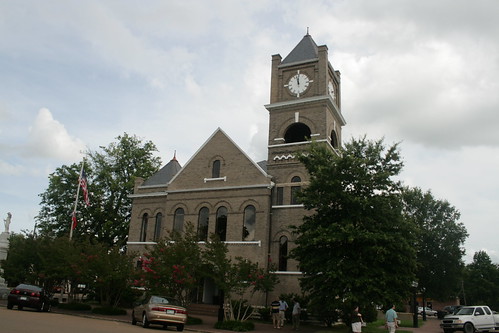the wellspring is the winter institute's mildly bi-annual newsletter; i've been charged with writing a piece on CRCL and my segue into working with the institute. i was given a 300-500 word range. it should be noted, however, that my writing process usually goes like this:
1. walk around and mutter
2. jot down notes
3. not know how to start
4. write a meta-passage that describes how difficult it is to start writing
5. double/nearly triple the word count i was initially given
so, i just sent susan glisson 1300 words, which i've copied whole at the end of this post - so that it sees the light of day before being drastically condensed. the strongest apology i have for the article's length is what happens in the first part - i ran across a newly formed blog from a student of mine (http://beyebrows.blogspot.com/), and it set the article's text afire. enjoy:
***
"Cultivating Criticism: Two Years of The Jim Hill Civil Rights/Civil Liberties Club"
1.
For a while, it seemed as if I’d never find a narrative vehicle for this article; writes and rewrites have mostly hovered around uncomfortably fast-paced personal histories – texts that anxiously try and get to the point, all the while clear that that point has plenty to do with my work, but little to do with me. This is fitting; my work in Mississippi for the past two years has been dedicated to creating spaces for others to fill, and to assist them in filling it with whatever they find most appropriate. So it is with the beginning to this article: a stage in which someone else is most appropriately the primary voice. This morning, a student of mine – from Jim Hill H.S. in Jackson, MS – commented on a recent blogpost, which lead me to her own newly formed blog, in which she writes: “I have a confession to make: I love Ole Miss. I've only visited the campus once, but I fell in love with the place. I'm a high school junior now, so I'm going to do my best this year so I can get a chance to go to Ole Miss. The reason why I am going to choose Ole Miss as a first choice is because of the William Winter Institute for Racial Reconciliation. Two fantastic teachers of mine have worked with them and I want to follow the trend and work for them also.”
Just barely beneath the surface of this “confession” are undercurrents of those crucial things I’ve been delighted to assist in cultivating within the Jim Hill community for the past two years, and which I could not have illustrated any better by personal history or anecdote: that the effects of a commitment within teachers and students to engage in a candid process of critical inquiry and open dialogue are deep and far-reaching; clearly, conflicts of race and identity run strong within and between us, and I find it meaningful that a student of mine – currently attending a 99% African-American high school – can engage in the richness and complexity of Ole Miss with a sense of genuine optimism and motivation (as very well she should), instead of the cynicism and hesitance that I so often see in her peers (and even her elders) regarding the University. It should be noted, moreover, that her visit to the campus came as part of a field trip with the Jim Hill Civil Rights/Civil Liberties Club (CRCL), of which I am co-facilitator. During our stop at Ole Miss (en route to the National Civil Rights Museum in Memphis) we spent time with Dr. Andy Mullins reflecting on the University Grays and the James Meredith controversy, and with Dr. Don Cole reflecting on his process of student radicalization/activism and eventual reconciliation with the University. So it was not just a walk in the Grove that has led this student to declare, “I love Ole Miss” – and rightly so.
2.
My ostensible role for the past two years at Jim Hill was that of mathematics teacher – leading courses in Algebra, Trigonometry, Calculus, and the like. However, as many (though not nearly enough) teachers will tell you, the school day neither begun at 8:15 nor ended at 3:30. It was within those spaces before, between, and after school that CRCL was begun. During the 2005-2006 school year, a colleague, Mr. Jacob Roth, and I – both first-year teachers and participants in the Mississippi Teacher Corps – found ourselves quickly and intensely fixed within the dilemma that a teacher won’t get anything done in a school building without engaging in and coming to terms with the community he or she is serving. However, throughout this process of engagement/coming to terms, Jacob and I became deeply interested in complex issues that appeared strongly tangled within our students’ identities and the identity of their community – e.g. teenage pregnancy, a culture of violence/machismo, hip hop and misogyny, racial signifiers and academic success, what Cornel West refers to as the “nihilistic threat in Black America,” etc. Though we wanted more and more to engage our students in dialogue about these and other topics, Jacob and I realized that it would have been wildly inappropriate for us to impose a particular agenda for approaching issues that clearly belonged to our students. The agenda itself had to come from within them as well (if at all), and all we could do was hope to craft and maintain a space wherein interested students could safely and productively engage in a critical look at themselves and their own community. From within this abstracted space – dedicated to cultivating critical inquiry and intercommunity dialogue – CRCL began to meet every Wednesday after school in Jake’s room.
Over a span of two years, CRCL expanded to include active participation from three high schools in the Jackson Metro area: two public, predominantly black – Jim Hill and Murrah High School – and one independently private, predominantly white – St. Andrew’s Episcopal School. We met week after week in either Jake or my room at Jim Hill – expanding to the library whenever we’d run out of space. Topics of inquiry and dialogue ranged from school resegregation, to organic farming, to hip-hop and misogyny, to the importance of voting, to Don Imus/Michael Richards, to global warming; speakers ranged from area hip-hop artist Kamikaze, to MS Supreme Court Justice James Graves, to former MS Governors William Winter and Ray Maybus, to NAACP State Congress President Derrick Johnson, to Movement activists Lawrence Guyot and Rims Barber; activities ranged from Holocaust memorial services at the local synagogue, to young voter registration, to assistance with the 2006 JPS Bond Issue campaign, to community service at a food bank, to participation in the MS Coalition for Racial Justice, to Movement-focused field trips to Ole Miss, Memphis, Birmingham, Montgomery, and Selma.
3.
Sometime in November of 2006, I – within a moment of deep frustration – gave Susan Glisson at the William Winter Institute a call. I told Susan the following: that I loved my students, I loved the work that I was doing, and I loved the community that I was working in, but that being a full-time classroom teacher was not something I wanted to continue doing; the aspects of my job I was passionate about – everything associated with CRCL as well my growing interest in education resource reform – seemed irresolvably at the periphery of my work. Susan and the Institute had worked with and supported CRCL previously, and I wanted to know if she had any advice as to how I could find a way to make community dialogue and education resource reform at the center of my workday. Seven months later, I am happy to have joined the Institute as a Project Coordinator – working on developing a state network of CRCL-like groups and developing a web-based teacher facilitation model to help integrate Civil Rights data and concepts into the classroom. However, I am all the more excited that along the process of opening up spaces for inquiry and dialogue, young people may value that process enough to “continue the trend” – as my student posted on her blog this morning. It is encouraging to know that even this space – the Institute – is yet another structure that is well filled by vastly different and thus differently effective voices, that I can participate in its development, that I can continue to connect with young people that will become passionate about the role it plays at the University and throughout the state, and that they in turn will continue to preserve the Institute’s commitment to critical inquiry and intercommunity dialogue – continuing it within their own community, and bringing it to others.
the twit
7.27.2007
7.12.2007
photopost 2: emmitt till commission
on the 40th anniversary of the 1964 murders of james chaney, andrew goodman, and michael schwerner, a multiracial community coalition in philidelphia, ms issued a call for justice in their deaths. despite overwhelming evidence, the state had not indicted anyone for the murder; a federal trial found seven of eighteen men guilty of civil rights violations (verdicts were not reached on two of the defendants), but - as killers walked free - many felt justice was hardly served. in tandem with the call for justice and in an effort to come to terms with its own historical legacy, the philidelphia coalition began the development of a civil rights tour and brochure, an oral history project, and local curriculum development surrounding the legacy of chaney, goodman, and schwerner. on june 21, 2005, former klansman edgar ray killen (80 years old at the time) was found guilty of manslaughter in connection with the disappearance and murder of the three civil rights workers.
***
the success of the philidelphia coalition's efforts has inspired sustained reconciliation practices in that community, as well as similar community action in other parts of the state. tallahatchie county has issued a call for justice and reconciliation in regards to the unresolved murder of emmett till - who, in august of 1955 was kidnapped in the night and subsequently abused and murdered on the accusation that he had whistled at a white women while leaving bryant's grocery and meat market in money, ms. the emmett till commission has borrowed greatly from the philidelphia model - involving a multiracial coalition, a legal strategy (although recent efforts at bringing charges have been dismissed), and plans for a tour/brochure.
***
susan glisson and the william winter institute provided - when necessary - structure, moderation, and guidance in philidelphia, and is doing the same in tallahatchie. we recently took a trip to tallahatchie to observe a meeting of the commission and to take pictures for the brochure. again, i was the de facto photographer - though it was profoundly difficult to take pictures of things that aren't there; so many of the buildings and landmarks involved in the emmett till story are in profound disrepair, and some are merely plots of land. so i took a million shots trying to pull enough identifiable landscape into the frame to make the space recognizable - sometimes managing, sometimes not.
***

belltower at the sumner courthouse, where an all-white, all-male jury acquitted (after a deliberation of just over an hour) roy bryant and j.w. milam of the charge of murder. within three months of their acquittal, the bryant and milam had confessed to the crime.
 former site of the delta inn - residence of the all-white jury during the trial
former site of the delta inn - residence of the all-white jury during the trial
 funeral home where emmett's body was embamled
funeral home where emmett's body was embamled
 glendora gin, from which a gin fan was acquired in order to tie to till's neck before throwing his body into the tallahatchie river.
glendora gin, from which a gin fan was acquired in order to tie to till's neck before throwing his body into the tallahatchie river.

former site of king's place - where a black reporter, james hicks, discovered information pertinent to the trial. specifically, hicks learned the names of two potential witnesses to the till murder, but who had been incarcerated under false names and charges.

former site of gas station where clinton melton - an outspoken member of the black community in the wake of the bryant/milam acquittals - was murdered. he was shot by milam's friend elmer kimbel, allegedly over a dispute regarding a gas tank. on the day of kimbel's trial (he was later acquitted), melton's widow, beulah, was run off the road near glendora and drowned in the black bayou.
 another view of where the gas station used to be
another view of where the gas station used to be


the mound at the end of the path is the site where till's mutilated body was found - the tallahatchie river is about 20 meters behind the camera; it had risen substantially in the weeks surrounding the murder.

[note: the source for most of this historical information is the text of the brochure that's being developed by the till commission]
***
the success of the philidelphia coalition's efforts has inspired sustained reconciliation practices in that community, as well as similar community action in other parts of the state. tallahatchie county has issued a call for justice and reconciliation in regards to the unresolved murder of emmett till - who, in august of 1955 was kidnapped in the night and subsequently abused and murdered on the accusation that he had whistled at a white women while leaving bryant's grocery and meat market in money, ms. the emmett till commission has borrowed greatly from the philidelphia model - involving a multiracial coalition, a legal strategy (although recent efforts at bringing charges have been dismissed), and plans for a tour/brochure.
***
susan glisson and the william winter institute provided - when necessary - structure, moderation, and guidance in philidelphia, and is doing the same in tallahatchie. we recently took a trip to tallahatchie to observe a meeting of the commission and to take pictures for the brochure. again, i was the de facto photographer - though it was profoundly difficult to take pictures of things that aren't there; so many of the buildings and landmarks involved in the emmett till story are in profound disrepair, and some are merely plots of land. so i took a million shots trying to pull enough identifiable landscape into the frame to make the space recognizable - sometimes managing, sometimes not.
***

belltower at the sumner courthouse, where an all-white, all-male jury acquitted (after a deliberation of just over an hour) roy bryant and j.w. milam of the charge of murder. within three months of their acquittal, the bryant and milam had confessed to the crime.
 former site of the delta inn - residence of the all-white jury during the trial
former site of the delta inn - residence of the all-white jury during the trial funeral home where emmett's body was embamled
funeral home where emmett's body was embamled glendora gin, from which a gin fan was acquired in order to tie to till's neck before throwing his body into the tallahatchie river.
glendora gin, from which a gin fan was acquired in order to tie to till's neck before throwing his body into the tallahatchie river.
former site of king's place - where a black reporter, james hicks, discovered information pertinent to the trial. specifically, hicks learned the names of two potential witnesses to the till murder, but who had been incarcerated under false names and charges.

former site of gas station where clinton melton - an outspoken member of the black community in the wake of the bryant/milam acquittals - was murdered. he was shot by milam's friend elmer kimbel, allegedly over a dispute regarding a gas tank. on the day of kimbel's trial (he was later acquitted), melton's widow, beulah, was run off the road near glendora and drowned in the black bayou.
 another view of where the gas station used to be
another view of where the gas station used to be
former site of j.w. milam's store

the mound at the end of the path is the site where till's mutilated body was found - the tallahatchie river is about 20 meters behind the camera; it had risen substantially in the weeks surrounding the murder.

susan glisson moderating
[note: the source for most of this historical information is the text of the brochure that's being developed by the till commission]
7.10.2007
metapost and photopost
metapost
i'm not sure what will become of the blog now that i've left the teacher corps; as much as i detested the required posting, it did tie me to a small amount of much-needed processing and communicating. so, without the mosquito-like specter of ben guest's mtc web-2.0-fetish i'm not sure where and when to shit my observations (as i'm no longer officially tied to mtc, i'm going to go ahead and use a wider [and perhaps more effective] range of language and imagery. that being said, i imagine the link to my blog [if it's in fact still up] will be swiftly removed once i admit once again that i'm a sexual being. and i am.).
shit them i must, however. and since i am still in mississippi, and will be working in education and social justice for another year (thanks to the william winter institute for racial reconciliation [wwirr]), this toilet is still relevant. my outlook for the 2007-2008 school year - which will contain the bulk of my 12-month project coordinator tenure at wwirr - is as follows:
(1) develop a state-wide network of student groups dedicated to cultural criticism/intercommunity dialogue/social justice,
(1.i) which will piggyback upon a massive young voter registration campaign, as well as
(1.ii) sustained coordination and development of the jim hill crcl centerpiece, and
(2) develop a web-based teacher facilitation model that assists educators in tying civil rights into any curricular objective,
(2.i) which will be integrated into continuing work at jim hill, hopefully
(2.ii) the instruction of a single section of calculus.
basically, a year to expand upon what had been forced to the periphery. overambitious, i'm sure - but no doubt things will shift and meld and surface and die. hopefully, then, this blogspace will continue to serve as an infrequent reservoir of whatever scrapple prevails.
***
photopost
as the de facto camera guy at wwirr, i've had rather unexpected demands to figure out how to use my new canon rebel xti - with varied success. it's a relief to be able to fall back on the point-and-click full auto mode, but playing around with the manual options is starting to make more sense. here's what i've got, and here's where i've been:
wwirr civil rights education summit 2007: day 1
 opening address by suzan johnson-cook
opening address by suzan johnson-cook
 lawrence guyot in a workshop
lawrence guyot in a workshop
 [?] in a workshop
[?] in a workshop
 the workshop itself
the workshop itself
 chancellor khayat introduces john hope franklin
chancellor khayat introduces john hope franklin
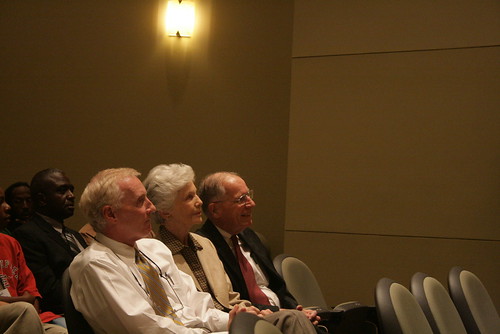
andy mullins, [?], former ms governor william winter listen to the chancellor's introduction
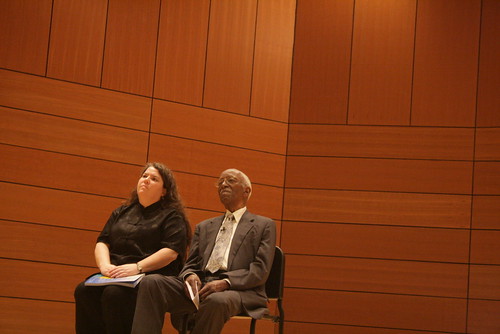
susan glisson and john hope franklin watch the chancellor as well

john hope franklin tells it like it is
 john hope franklin post-speech
john hope franklin post-speech
 a portrait of john hope franklin
a portrait of john hope franklin
wwirr civil rights education summit 2007: days 2-3

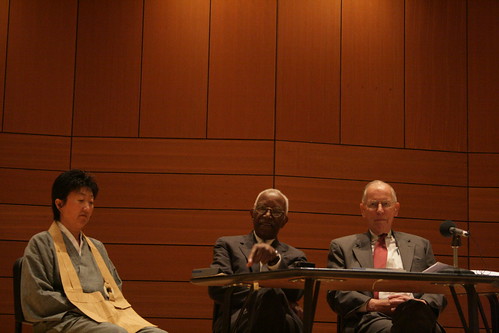

 the panel discussion
the panel discussion
 a session with margaret block
a session with margaret block
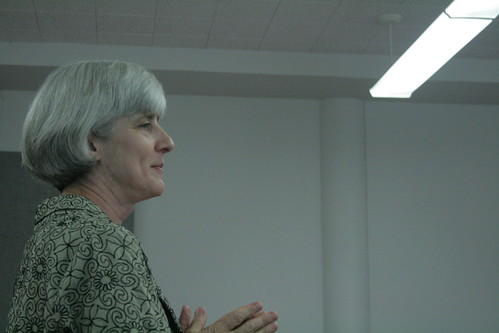 a session with deborah menkart
a session with deborah menkart

 session
session
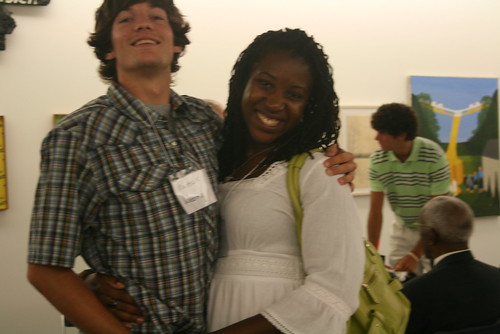 people i work with 1: patty cakes and annette
people i work with 1: patty cakes and annette
 people i work with 2: my boss, dr. susan glisson
people i work with 2: my boss, dr. susan glisson
 people i work with 3: patty cakes and jeremy
people i work with 3: patty cakes and jeremy
 people i work with 4: fantastic amy (but she's moved on)
people i work with 4: fantastic amy (but she's moved on)
 people i work with 5: me
people i work with 5: me
 people i work with 6: ms. jordan butler
people i work with 6: ms. jordan butler
i'm not sure what will become of the blog now that i've left the teacher corps; as much as i detested the required posting, it did tie me to a small amount of much-needed processing and communicating. so, without the mosquito-like specter of ben guest's mtc web-2.0-fetish i'm not sure where and when to shit my observations (as i'm no longer officially tied to mtc, i'm going to go ahead and use a wider [and perhaps more effective] range of language and imagery. that being said, i imagine the link to my blog [if it's in fact still up] will be swiftly removed once i admit once again that i'm a sexual being. and i am.).
shit them i must, however. and since i am still in mississippi, and will be working in education and social justice for another year (thanks to the william winter institute for racial reconciliation [wwirr]), this toilet is still relevant. my outlook for the 2007-2008 school year - which will contain the bulk of my 12-month project coordinator tenure at wwirr - is as follows:
(1) develop a state-wide network of student groups dedicated to cultural criticism/intercommunity dialogue/social justice,
(1.i) which will piggyback upon a massive young voter registration campaign, as well as
(1.ii) sustained coordination and development of the jim hill crcl centerpiece, and
(2) develop a web-based teacher facilitation model that assists educators in tying civil rights into any curricular objective,
(2.i) which will be integrated into continuing work at jim hill, hopefully
(2.ii) the instruction of a single section of calculus.
basically, a year to expand upon what had been forced to the periphery. overambitious, i'm sure - but no doubt things will shift and meld and surface and die. hopefully, then, this blogspace will continue to serve as an infrequent reservoir of whatever scrapple prevails.
***
photopost
as the de facto camera guy at wwirr, i've had rather unexpected demands to figure out how to use my new canon rebel xti - with varied success. it's a relief to be able to fall back on the point-and-click full auto mode, but playing around with the manual options is starting to make more sense. here's what i've got, and here's where i've been:
wwirr civil rights education summit 2007: day 1
 opening address by suzan johnson-cook
opening address by suzan johnson-cook lawrence guyot in a workshop
lawrence guyot in a workshop [?] in a workshop
[?] in a workshop the workshop itself
the workshop itself chancellor khayat introduces john hope franklin
chancellor khayat introduces john hope franklin
andy mullins, [?], former ms governor william winter listen to the chancellor's introduction

susan glisson and john hope franklin watch the chancellor as well

john hope franklin tells it like it is
 john hope franklin post-speech
john hope franklin post-speech a portrait of john hope franklin
a portrait of john hope franklinwwirr civil rights education summit 2007: days 2-3

angela oh, john hope franklin, governor winter and michael wenger before the panel discussion


 the panel discussion
the panel discussion a session with margaret block
a session with margaret block a session with deborah menkart
a session with deborah menkart
 session
session people i work with 1: patty cakes and annette
people i work with 1: patty cakes and annette people i work with 2: my boss, dr. susan glisson
people i work with 2: my boss, dr. susan glisson people i work with 3: patty cakes and jeremy
people i work with 3: patty cakes and jeremy people i work with 4: fantastic amy (but she's moved on)
people i work with 4: fantastic amy (but she's moved on) people i work with 5: me
people i work with 5: me people i work with 6: ms. jordan butler
people i work with 6: ms. jordan butler
Subscribe to:
Comments (Atom)




